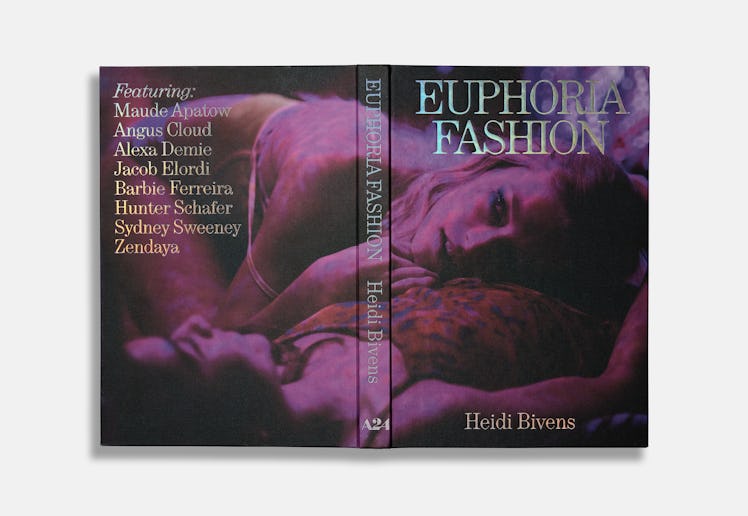Heidi Bivens, the costume designer for the HBO series Euphoria, has always had an innate awareness of how clothes identify us. “I understood early on how making decisions about what you put on was communicating something to the world,” says Bivens in Euphoria Fashion, a new book published by A24 that catalogs the making of the show’s looks. “I understood the power of navigating different groups of people by choosing whether or not to stand out or not.”
Hunter Schafer and Zendaya as Jules and Rue.
This understanding is clear to even the most casual viewer of her work. A glimpse at the screen on a Sunday night reveals the masculine apathy of Nate’s tee-shirts and jeans, the baby pinks and blues of Cassie, a girl spilling into womanhood, the security blanket role of Rue’s burgundy hoodie.
Alexa Demie as Maddy.
The book, like the series, is intricate and exquisitely designed. The cloth-bound volume is filled with Nick Knight-inspired flat lays of iconic costumes like Maddy’s I.AM.GIA set, conversations with the cast and creator Sam Levinson, and a forward by Jeremy Scott. “I had spoken with the book’s editor, LinYee Yuan, early on about wanting the book to feel in-depth and comprehensive about the craft of costume design,” Bivens tells me. “I told them, ‘Please just put as many photographs and behind-the-scenes shots that people have not seen yet in the book.’ But I also wanted it to be balanced with an academic approach and to have real fashion journalists who are interested in the history and the social context, current and past, of clothing.”
Hunter Schafer as Jules.
An essay titled Bound: Normcore as Fashion Bondage by William Van Meter explores the pointedly average clothing of the show’s toxic male protagonists, Nate and his father, Cal. “They are wolves in sheep’s clothing,” asserts Van Meter. “And honey, those sheep are kinky, conflicted, and norm to the core.” In another essay, Memes, Moods, and Miu Miu Eras, Biz Sherbert examines the internet’s preoccupation with the costumes’ lack of vérité, the idea that no “real” teenager would wear Jacquemus or a leather harness to school: “Rating the overall success of a look on its site-specific wearability feels outdated when a look today is most successful when it can be described simply as a ‘mood,’” Sherbert posits. “A mood is by definition incorporeal, meaning you can channel Cassie’s full-blown school bathroom breakdown in a cornflower country music star dress, when you’re really just feeling a little unhinged and wearing a touch of blue eyeshadow.”
Sydney Sweeney as Cassie.
“I decided to forgo reality for visual impact,” declares Bivens. Between the essays and character studies are “Odes,” short pieces on the history of the tennis skirt, Converse Chuck Taylors, and matching sets—essential pieces in the show’s wardrobe.
Equal parts thought-provoking and visually decadent, the book is an obvious must for fans of Euphoria. Still, all design-lovers and anyone who enjoys watching, rewatching, dissecting, and then analyzing what makes something great will delight in it as well.
